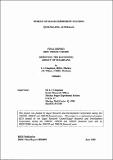| Abstract | Good ratooning cultivars has attributes of rapdi canopy development, associated with early development of adequate stalk numbers, for increased interception of light in early growth, an stability of harvested stalk weight to maintaine yields over the ratoon cycle. These conclusions were drawn from Project BS7S conducted at Tully and Mackay for plant crops and two or three ratoons, respectively. This current project had the objective to determine if these attributes were applicable to older ratoon crops grown at Mackay.A concern with the early project was that geno x crop and genotype x year interactions were confounded. In order to overcome this concern, sixth and seventh ratoon crops of rainfed and irrigated cane were grown adjacent to irrigated crops of plant and first ratoons in this project. All three experiments had the same six cultivars known to have differenet ratooning potential. Comparing the sugar yields for plant and first ratoon with sixth and seventh ratoon crops, there were three groups of cultivars with regard to yield: no decline Q124, Q138); slight decline (q87, NCo310); and large decline (Q50, Q68).The good ratooning cultivats achieved production through the attributes established in the early project. Early canopy development was also associated with cultivars which maintained stool production, that is, they did not develop gaps following harvester damage when crops lodged. The gappiness of ratoons of the good ratooning cultivar Q124 was higher than that for Q138 and NCo310, two cultivars which suffered no harvester damage and developed few gaps. Gaps were the sum of distances greater than 0.5 m between stools. Although Q124 developed 20% gaps along the cane row, individual gaps were usually less then 0.75 m and early canopy development was only slightly retarded and the cultivar was able to compensate for this disability. When yield was adjusted for gappiness, sugar production per stool for all cultivars was shown to be relatively constant over the complete crop cycle. This result has significant industry implications for it indicates that yields in ratoon crops can be stabilised if the stool population cane be maintained. Therefore, reducting harvester damage to stools appears to be a key to maintaining production during long ratooning cycles.Returns were calculated for varying crop cycle lengths from plant/fallow to plant/seven ratoons/fallow, assuming the current price of sugar and current costs for fixed, operating and harvesting expenses. Return data followed the trends for yield, and there were three distinct groups of cultivars, namely: Q124, Q138 high; Q87, NCo310 medium; and Q50, Q68 low. The high and medium groups of cultivars had a plateauing of returns with crop cycles between four and seven ratoons, while the low group had plateauing between two and seven ratoons. There were large differences in maximum returns which averaged 1946, 1425 and 628 $/ha for the high, medium and low producing cultivars respectively, for irrigated cane. The newest varieties had the highest returns, indicating that plant breeders have been successful in releasing higher performing cultivars between 1946 and 1994, the period over which these cultivars were first released for commercial production. Irrigated cane gave higher returns than rainfed cane and the new cultivars had larger increases in returns form irrigation that the old cultivars. |

